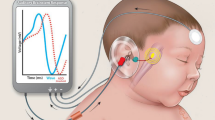Abstract
Children with the diagnosis of autism were tested for brainstem auditory evoked potentials (BAEP), and information was gathered on their medical and developmental histories and current developmental levels of symptomatology. On comparing the nine autistic children having abnormal BAEPs and the seven autistic children with normal BAEPs, the former were found to have exhibited greater pathology in the areas of attention and social accessibility. No differences were found between the groups on measures of language, motor, or perceptual functioning, or on previous diagnoses or medical history. It is suggested that social and attentional pathology may be more specifically associated with the brainstem pathology that may characterize autism than are symptoms in other developmental areas.
Similar content being viewed by others
References
Achenbach, T. The Child Behavior Profile: I. Boys aged 6–11.Journal of Consulting and Clinical Psychology, 1978,46, 478–488.
Chiappa, K., & Norwood, A. Brainstem auditory evoked responses in clinical neurology: Utility and neuropathological correlates.Electroencephalography and Clinical Neurophysiology, 1977,43, 518.
Connor, K. Connor's Parent Scales.Psychopharmacology Bulletin, special supplement, 1973.
DeMyer, M., Churchill, D., Pontius, M., & Gilkey, K. A comparison of five diagnostic systems for childhood schizophrenia and infantile autism.Journal of Autism and Childhood Schizophrenia, 1971,1, 175–189.
Doll, E.Vineland Social Maturity Scale Manual. Minneapolis: Educational Test Bureau, 1965.
Hauser, S., DeLong, G., & Rosman N. Pneumographic findings in the infantile autism syndrome.Brain, 1975,98, 667–688.
Hecox, K., & Galambos, R. Brain stem auditory evoked responses in human infants and adults.Archives of Otolaryngology, 1974,99, 30–33.
Hutt, C., Hutt, S., Lee, D., & Ounsted, C. Arousal and childhood autism.Nature, 1964,204, 908.
Jewett, D., Romano, M., & Williston, J. Human auditory evoked potentials: Possible brainstem components detected on the scalp.Science, 1970,167, 1517–1578.
Jewett, D., & Williston, J. Auditory-evoked far fields averaged from the scalp of humans.Brain, 1971,94, 681–696.
Krug, D., Arick, J., & Almond, P. Behavior checklist for identifying severely handicapped individuals with high levels of autistic behavior.Journal of Child Psychology and Psychiatry, in press.
Leech, R., & Alvord, E. Anoxic-ischemic encephalopathy in the human neonatal period.Archives of Neurology, 1977,34, 109–113.
Lobascher, M., Kingerlee, P., & Gubbay, S. Childhood autism: An investigation of etiological factors in twenty-five cases.British Journal of Psychiatry, 1970,117, 525–529.
MacCulloch, M., & Williams, C. On the nature of infantile autism.Acta Psychiatrica Scandinavica, 1971,47, 295–314.
McGinn, J.Four Language Assessment Scales. Boston: League School, Government Center, 1979.
Ornitz, E. Vestibular dysfunction in schizophrenia and childhood autism.Comprehensive Psychiatry, 1970,11, 159–173.
Ornitz, E., Guthrie, D., & Farley, A. The early symptoms of childhood autism. In G. Serban (Ed.),Cognitive defects in the development of mental illness, New York: Brunner/Mazel, 1978.
Ornitz, E., & Ritvo, E. Medical assessment. In E. Ritvo (Ed.),Autism: Diagnosis, current research and management. New York: Spectrum, 1976.
Picton, T., & Hillyard, S. Human auditory evoked potentials. II. Effects of attention.Electroenphalography and Clinical Neurophysiology, 1974,36, 191–200.
Picton, T., Hillyard, S., Galambos, R., & Schiff, M. Human auditory attention: A central or peripheral process?Science, 1971,171, 351–353.
Rimland, B.Infantile autism. New York: Appleton-Century-Crofts, 1964.
Rimland, B. The differentiation of childhood psychoses.Journal of Autism and Childhood Schizophrenia, 1971,1, 161–174.
Robinson, K., & Rudge, P. Abnormalities of the auditory evoked potentials in patients with multiple sclerosis.Brain, 1977,100, 19–40.
Rutter, M. Concepts of autism: A review of research.Journal of Child Psychology and Psychiatry, 1968,9, 1–25.
Salamy, A., & McKean, C. Postnatal development of human brainstem potentials during the first year of life.Electroencephalography and Clinical Neurophysiology, 1976,40, 418–426.
Schopler, E., Reichler, R. J., DeVellis, R. F., & Daly, K. Toward objective classification of childhood autism: Childhood Autism Rating Scale (CARS).Journal of Autism and Developmental Disorders, 1980,10, 91–103.
Simon, N. Echolalic speech in childhood autism. Consideration of possible underlying loci of brain damage.Archives of General Psychiatry, 1975,32, 1439–1448.
Skoff, B., Mirsky, A., & Turner, D. Prolonged brainstem transmission time in autismPsychiatry Research, 1980,2, 157–166.
Starr, A., & Achor, J. Auditory brain stem responses in neurological disease.Archives of Neurology, 1975,32, 761–768.
Starr, A., & Achor, J. Anatomical and physiological origins of auditory brain stem responses (ARB). In D. Lehmann & E. Callaway (Eds.),Human evoked potentials: Applications and problems. New York: Plenum Press, 1979.
Starr, A., & Hamilton, A. Correlation between confirmed sites of neurological lesions and abnormalities of far field auditory brainstem responses.Electroencephalography and Clinical Neurophysiology, 1976,41, 595–608.
Stockard, J., Stockard, J., & Sharbrough, F. Detection and localization of occult lesions with brainstem auditory responses.Mayo Clinic Proceedings, 1977,52, 261–269.
Stockard, J., Stockard, J., & Sharbrough, F. Nonpathologic factors influencing brainstem auditory evoked potentials.American Journal of EEG Technology, 1978,18, 177–209.
Student, M., & Sohmer, H. Evidence from auditory nerve and brainstem evoked responses for an organic brain lesion in children with autistic traits.Journal of Autism and Childhood Schizophrenia, 1978,8, 13–20.
Student, M., & Sohmer, H. Erratum.Journal of Autism and Developmental Disorder, 1979,9, 309.
Windle, W., Becker, R., & Weil, A. Alterations in brain structure after asphyxiation at birth.Journal of Neuropathology and Experimental Neurology, 1944,3, 224–238.
Author information
Authors and Affiliations
Additional information
This work was supported in part by the following grants: NS-12201 from NINCDS-NIH, K3-14,915 from NIMH-ADAMHA (Research Scientist Award to A. F. Mirsky), MHOO250 from NIMH-ADAMHA (Research Scientist Development Award to D. Fein), MH-15189 (NIMH, Research Training Grant to B. Skoff), and UHGRS-561 from University Hospital. We wish to thank Dr. Fred Krell, Joseph Piette, and the staff and students at the May Institute, Chatham, Massachusetts.
Rights and permissions
About this article
Cite this article
Fein, D., Skoff, B. & Mirsky, A.F. Clinical correlates of brainstem dysfunction in autistic children. J Autism Dev Disord 11, 303–315 (1981). https://doi.org/10.1007/BF01531513
Issue Date:
DOI: https://doi.org/10.1007/BF01531513




